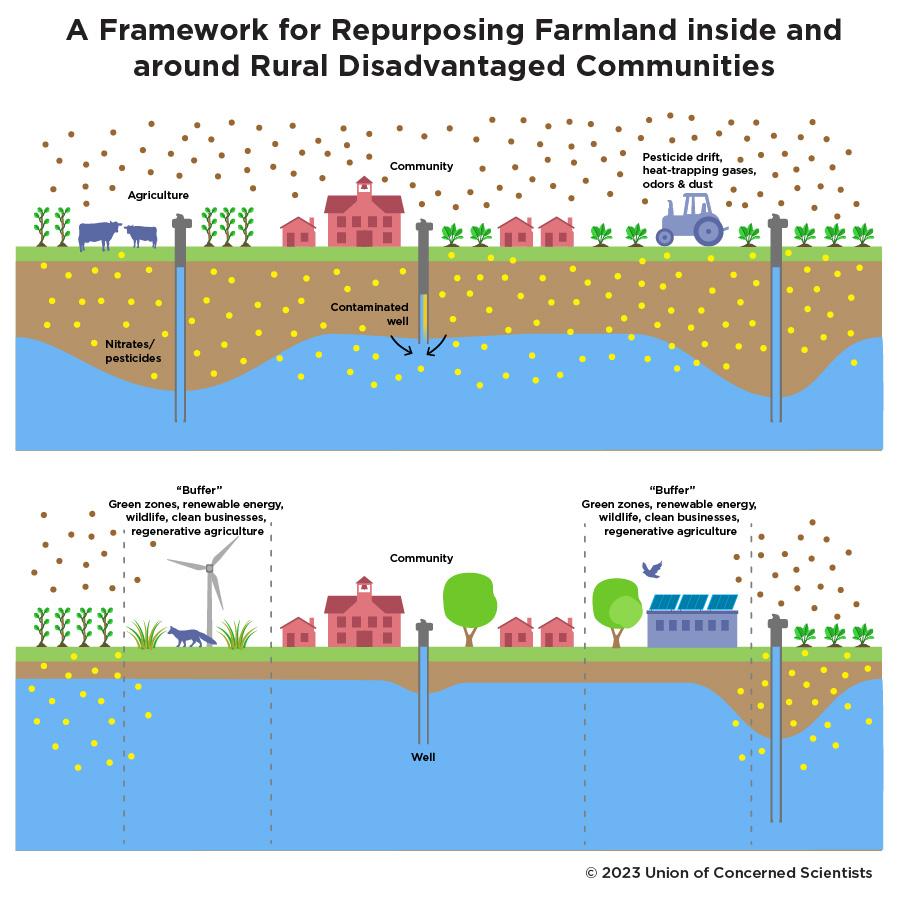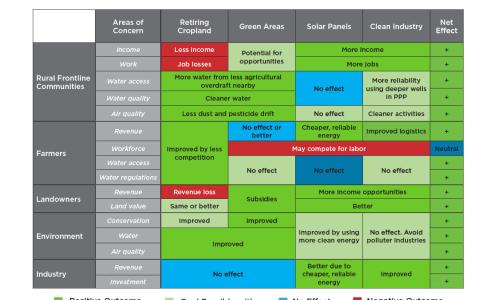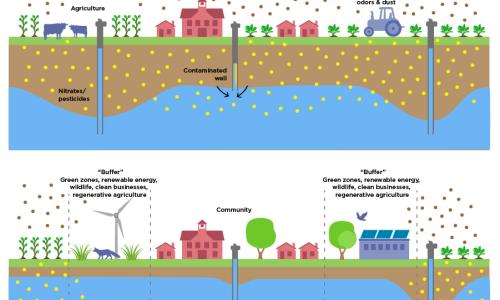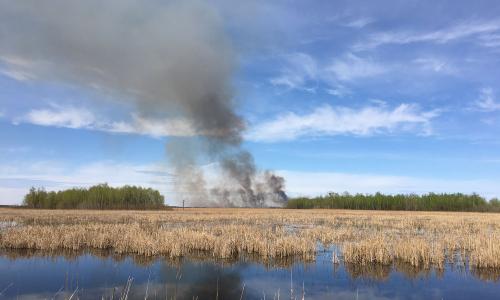Californians pay billions for the negative side effects of extractive agriculture.
Frontline communities pay, in addition, with their health. In contrast, cropland repurposing informed by communities and science can provide social, environmental, and economic benefits for all stakeholders. The goal is to maximize public benefits for public dollars.
Cropland Repurposing in California
How to Invest Public Funds to Benefit All
Californians pay billions to compensate for the costs of negative side effects of extractive agriculture that agricultural economic models traditionally ignore. Frontline communities pay, in addition, with their health. In contrast, cropland repurposing informed by communities and transdisciplinary science can provide social, environmental, and economic benefits for all stakeholders. The goal is to maximize public benefits for public dollars.
-
Priority #1: Repurpose agriculture inside rural disadvantaged communities. The economic costs of the negative side effects of extractive agriculture inside these communities exceed the revenues generated.
-
Priority #2: Repurpose extractive agriculture around rural disadvantaged communities. Groundwater overextraction is drying out wells in these communities, while bad actors carelessly spray pesticides over people.
-
Priority #3: Repurpose other cropland after a transparent process that accounts for all socioenvironmental and economic tradeoffs.
In sum, public funds should be used to transition away from extractive agriculture toward a sustainable and diversified economy that benefits local farmers, communities, and the environment.
Too Little Water in California to Support Current Land Uses
California's water resources are limited. The dramatic depletion of groundwater primarily for irrigated agriculture triggered California's Sustainable Groundwater Management Act (SGMA) in 2014. SGMA aims to make groundwater use sustainable by reducing pumping and increasing groundwater storage. To achieve this goal, California must repurpose about 1 million acres of irrigated farmland into sustainable land uses.
Cropland repurposing is a solution to allow agriculture to become sustainable at a feasible pace, rather than leave farmers to face drastic consequences imposed by the market as water scarcity grows. The Multibenefit Land Repurposing Program of the California Department of Conservation offers public funding to help with this transition in a way to benefit all the involved stakeholders, with a focus on disadvantaged communities.
This fact sheet uses peer-reviewed science (Fernandez-Bou et al. 2021a; Fernandez-Bou et al. 2021b; Fernandez-Bou et al. 2023) to answer a key question: Where should we repurpose cropland to maximize public benefits with a focus on disadvantaged communities?
Here, we assess why public funds should be used to transition away from extractive agriculture (water-intensive, soil-degrading, not locally owned, contributing little to the local economy, monoculture, high input of fertilizers and pesticides) (O'Connell and Peters 2021) toward a sustainable, diversified economy that benefits local farmers, communities, and the environment (Figure 1). We focus on the San Joaquin Valley and its 123 small rural disadvantaged communities. About half a million people live there and household income is less than half of the state median.

Priority #1: Repurpose Cropland inside Rural Disadvantaged Communities
Inside the 123 small rural communities of the San Joaquin Valley, extractive agriculture applies 1.15 million pounds of pesticides per year and leaches about 19 million pounds of nitrate to the aquifers. As a result, toxic tap water and poor air quality lead to increased health costs, missed work and school days, and, ultimately, lower life expectancy.
Agriculture inside the 123 communities generates about $170 million per year (2016 US dollars), but it does not pay for its own negative side effects. An example is pollution of the aquifers that residents rely on for drinking water.
The estimated cost of providing only one gallon of bottled water per person a day is $190 million per year. And the costs soar when considering other negative impacts, such as the social cost of carbon dioxide emissions and community wells gone dry because agriculture depletes community aquifers (Pauloo et al. 2021; Bostic et al. 2023).
It is more expensive for Californians to allow extractive agriculture inside these disadvantaged communities than not. Priority #1 would repurpose 54,000 acres inside rural disadvantaged communities in the valley, saving about 146,000 acre-feet of water per year.
Priority #2: Repurpose Cropland around Rural Disadvantaged Communities
Imagine a well in an average-sized California farm (348 acres) pumping three acre-feet of groundwater per acre per year, which is more than 1,000 acre-feet per year. This is a very reasonable assumption. However, considering the natural groundwater recharge in the San Joaquin Valley, if that well is less than one mile from a community, it will withdraw water from the community's aquifer. That practice has already led to thousands of household wells running dry (Pauloo et al. 2021; Bostic et al. 2023).
Within one mile around each of the 123 rural disadvantaged communities of the San Joaquin Valley, agriculture uses 1.3 million acre-feet of water for irrigation every year (about half the amount of water used by all Californians). Yet many of the half million residents of these communities (and of the 4.3 million residents of the San Joaquin Valley) lack water security—because they cannot access their own water.
Conventional agriculture also leaches 173 million pounds of toxic nitrate into aquifers in that mile-wide area surrounding the communities—about one pound per person per day. Because common fertilizers are extremely inefficient (plants only use about 30 percent of them), about 10 percent of the fertilizer becomes nitrous oxide, a heat-trapping gas 300 times more powerful than carbon dioxide. Heat-trapping gas emissions from the fertilizer used around these communities are equivalent to the emissions of about 360,000 fossil-fueled cars.
Based on the Environmental Protection Agency's proposed rates for the social cost of heat-trapping emissions, $190 per metric ton of carbon dioxide—equivalent (CO2e) emissions (US EPA, 2022), the fertilizer use around those communities costs all of us about $350 million per year. And this does not consider emissions from local livestock that might double the social cost. All Californians pay all those costs, while extractive agricultural corporations privatize their profits and deplete local economies.
Each year, conventional agriculture applies 9.6 million pounds of pesticide around these communities—1.6 pounds per person per month of a product designed to kill. Residents live in fear that they, their children, and their pets will be sprayed with pesticides when they go outdoors (Flores-Landeros et al. 2022). To avoid pesticide drift, residents often do not open their windows to refresh their homes at night, even though they may lack air conditioning amid the San Joaquin Valley's scorching summer. Outdoors workers may be unable to cool down at night, making them more prone to heat exhaustion, heat stroke, and accidents. Farmworkers die from heat-related illnesses 20 times more often than the US average (National Farm Worker Ministry 2022).
Repurposing agriculture within one mile of the 123 small rural communities of the San Joaquin Valley may reduce the use of 1.45 million acre-feet of water, 11 million pounds of pesticides, 193 million pounds of nitrate leaching to the aquifers, and 1.85 million metric tons of CO2e. Altogether, those negative side effects are currently costing hundreds of millions of dollars per year to taxpayers and community residents.
Priority #3: Develop a Transparent Process to Assess the Full Costs and Benefits
After repurposing land inside and around rural disadvantaged communities, the third priority is to develop, along with local communities, a transparent process that uses full cost and benefit accounting to compare different new land uses (Table 1).

Adapted from Fernandez-Bou et al. 2023.
The negative side effects of extractive agriculture already cost Californians billions of dollars because they have been systematically ignored by agricultural economic models. The current and potential negative side effects include economic impacts of groundwater depletion on water security, health and economic costs of water and air pollution, and the social costs of heat-trapping emissions (Fernandez-Bou et al. 2021b; Flores-Landeros et al. 2022; Perrone et al. 2023).
To foster good practices, land repurposing policies can:
-
Avoid repurposing land that hosts regenerative agriculture, agroecology, organic farming, or other practices that improve the local environment and protect residents from low-quality water and air.
-
Repurpose land that uses pesticides and synthetic fertilizers near populations and sensitive environmental areas.
-
Promote small farming and locally owned farms whose owners live on the land and produce diverse, nutritious foods for a healthy human diet.
-
Facilitate access to land for those who care about it and commit to use it in a sustainable and beneficial way.
-
Foster local economies by limiting extractive business and improve the quality of life while preventing gentrification of the improved communities.
Acknowledgments
This report was made possible through the generous support of the Water Foundation, and UCS members.
For their thoughtful comments, the authors thank Nataly Escobedo-Garcia, Leadership Counsel for Justice and Accountability; Leticia Classen-Rodriguez, SocioEnvironmental and Education Network; Sam Sandoval-Solis, University of California-Davis; José M. Rodríguez-Flores, Environmental Defense Fund; Jennifer Clary, Clean Water Action; and Tom Harmon, University of California-Merced.
Organizational affiliations are listed for identification purposes only. The opinions expressed herein do not necessarily reflect those of the organizations that funded the work or the individuals who reviewed it. The Union of Concerned Scientists bears sole responsibility for the report's contents.
References
Bostic, Darcy, Linda Mendez-Barrientos, Rich Pauloo, Kristin Dobbin, and Victoria MacClements. 2023. "Thousands of Domestic and Public Supply Wells Face Failure Despite Groundwater Sustainability Reform in California's Central Valley." Scientific Reports 13 (1): 14797. https://doi.org/10.1038/s41598-023-41379-9
EPA (US Environmental Protection Agency). 2022. "Report on the Social Cost of Greenhouse Gases: Estimates Incorporating Recent Scientific Advances." External Review Draft. September. Washington, DC: EPA. https://www.epa.gov/system/files/documents/2022-11/epa_scghg_report_draft_0.pdf
Fernandez-Bou, Angel Santiago, J. Pablo Ortiz-Partida, Leticia M. Classen-Rodriguez, Chantelise Pells, Kristin B. Dobbin, Vicky Espinoza, José Manuel Rodríguez-Flores, et al. 2021a. "3 Challenges, 3 Errors, and 3 Solutions to Integrate Frontline Communities in Climate Change Policy and Research: Lessons from California." Frontiers in Climate 3: 717554. https://www.frontiersin.org/articles/10.3389/fclim.2021.717554/full
Fernandez-Bou, Angel Santiago, J. Pablo Ortiz-Partida, Kristin B. Dobbin, Humberto Flores-Landeros, Leigh A. Bernacchi, and Josué Medellín-Azuara. 2021b. "Underrepresented, Understudied, Underserved: Gaps and Opportunities for Advancing Justice in Disadvantaged Communities." Environmental Science & Policy 122: 92--100. https://doi.org/10.1016/j.envsci.2021.04.014
Fernandez-Bou, Angel Santiago, J. Pablo Ortiz-Partida, Chantelise Pells, Leticia M. Classen-Rodriguez, Vicky Espinoza, José M. Rodríguez-Flores, and Josué Medellín-Azuara. 2022. San Joaquin Valley Regional Report, California's Fourth Climate Change Assessment. Sacramento, CA: California Natural Resources Agency. https://www.energy.ca.gov/sites/default/files/2022-01/CA4_CCA_SJ_Region_Eng_ada.pdf
Fernandez-Bou, Angel Santiago, José M. Rodríguez-Flores, Alexander Guzman, J. Pablo Ortiz-Partida, Leticia M. Classen-Rodriguez, Pedro A. Sánchez-Pérez, Jorge Valero-Fandiño, et al. 2023. "Water, Environment, and Socioeconomic Justice in California: A Multi-benefit Cropland Repurposing Framework." Science of the Total Environment 858: 159963. https://doi.org/10.1016/j.scitotenv.2022.159963
Flores-Landeros, Humberto, Chantelise Pells, Miriam S. Campos-Martinez, Angel Santiago Fernandez-Bou, José Pablo Ortiz-Partida, and Josué Medellín-Azuara. 2022. "Community Perspectives and Environmental Justice in California's San Joaquin Valley." Environmental Justice 15 (6): 337-345. https://doi.org/10.1089/env.2021.0005
National Farm Worker Ministry. 2022. "Health & Safety." https://nfwm.org/farm-workers/farm-worker-issues/health-safety
O'Connell, D. J., and S. J. Peters. 2021. In the Struggle: Scholars and the Fight Against Industrial Agribusiness in California. New Village Press. https://nyupress.org/9781613321225/in-the-struggle
Pauloo, R. A., A. Escriva-Bou, H. Dahlke, A. Fencl, H. Guillon, and G.E. Fogg. 2020. "Domestic Well Vulnerability to Drought Duration and Unsustainable Groundwater Management in California's Central Valley." Environmental Research Letters 15 (4) 044010. https://doi.org/10.1088/1748-9326/ab6f10
Perrone, Debra, Melissa M. Rohde, Courtney Hammond Wagner, Rebecca Anderson, Samantha Arthur, Ngodoo Atume, and Meagan Brown, et al. 2023. Stakeholder integration predicts better outcomes from groundwater sustainability policy. Nature Communications 14: 3793. https://doi.org/10.1038/s41467-023-39363-y
Downloads
Citation
Union of Concerned Scientists. 2023. Cropland Repurposing in California: How to Invest Public Funds to Benefit All. Cambridge, MA. https://www.ucsusa.org/resources/cropland-repurposing-california





